They don’t make ‘em like they used to – and in many cases, not at all. Have you ever wondered what happened to them? And why?
Station wagons –
You can still buy a wagon, of course – but not like they used to make ‘em. Because no one makes a rear-drive/V8-powered one that can seat nine people (two or three of them seated facing backwards) that pulls a 5,00 pound trailer and cost about what people pay today for a mid-size/front-drive car that seats five – and doesn’t pull anything.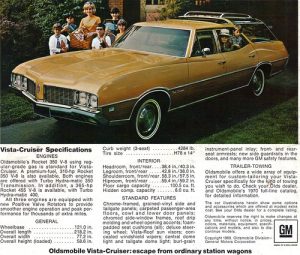
Like the great herds of sauropods that once roamed the grasslands, it was once the case that every second or third car you saw was a big wagon – and that was because (in those days) almost every car you saw was full-size, rear-drive and powered by a big V8. The wagons were a stretch job based on these cars – and pretty much every car company that sold one of the former also sold one of the latter, too. They were the SUVs of their era – before there were SUVs.
While the great sauropods were done in by an asteroid the size of Everest that slammed into the Earth just off the coast of central America, the great wagons were done in less naturally – by the first round of federal fuel economy fatwas, which were enacted back in the ‘70s. For the first time in the history of the country, the government decided that the people would no longer be allowed to decide for themselves how important (or not) gas mileage was. The risible idea being that the evil car companies would never build cars that used less gas unless forced to build them – because the car companies would never respond to market demand for more fuel-efficient cars.
Anyhow, the government decided on behalf of car buyers – and without having asked them – that they would have cars that got good gas mileage . . . whether they wanted them or not. And the big cars that they did want didn’t get good gas mileage – and so they had to go. The V8s were too thirsty, the body-on-frame construction too heavy.
The wagons that were based on them were, of course, even worse – and so they went, too.
Hilariously – tragically – the “thirsty” wagons have been replaced by even thirstier SUVs – which came into existence because of a “loophole” in the gas-mileage-uber-alles regs (since closed) that applied a less-onerous MPG standard to what were then styled “light trucks” rather than cars. So – because the market still very much wanted big rigs with big engines, no matter what the government wanted – the car companies built them out of “light trucks” and called them SUVs.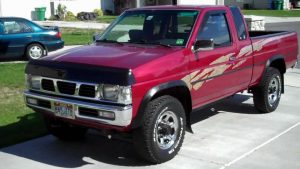
And they still roam the roads today.
Small trucks –
Today, the smallest truck you can buy is a mid-sized truck – and that truck is nearly as big as the full-size trucks of the 1990s. Hilariously – tragically – the mid-sized trucks of today can’t haul as much as the small trucks of yesterday.
Because all of them have more cab than bed. 
You can’t get a new mid-sized truck with fewer than four doors, which usually means no more than a five-foot bed. The compact trucks of the not-so-distant past were available with two doors – and came standard with a six-foot bed. With the tailgate dropped, you had an almost eight-foot bed, the same length bed as a full-size truck . . . but without the full-size rest of the truck.
These little – but very useful – trucks were immensely popular. Examples included the Ford Ranger (not the current Ranger) and the Nissan Frontier (not the current Frontier). Some of them were available with four-wheel-drive . . . with a four cylinder engine. You weren’t upsold to a V6 to get 4WD.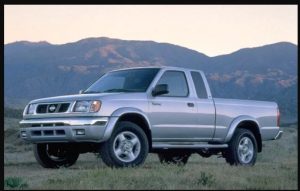
Which brings us to why they’re not around anymore.
The margins were too low. Ford could (and does) make more money selling you a full-sized F-150 than a (no longer available) Ranger; same goes for Nissan – which would rather sel you a $35,000 full-size/4WD Titan than a $22,000 compact-sized 4WD Frontier (old model).
There’s another reason, too. Something called the “chicken tax” – which dates back to the ‘60s and a trade war over . . . chicken. In retaliation over tariffs applied to exported chicken, Congress imposed a tariff on imported small trucks. This made it more expensive to sell compact-sized trucks made overseas over here – and so they stopped selling them.
Leaving American buyers with the choice of large (and largely useless) mid-sized trucks and useful but much more expensive full-size trucks.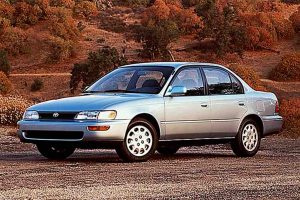
Once again, brought to you by Uncle.
Economical economy cars –
There hasn’t been much progress, gas-mileage-wise, since the ‘90s – insofar as gas mileage goes. Check the stats if you (cue Scotty from the originalStar Trek) dinna believe me. A 1995 Toyota Corolla rated 28 city, 34 highway. A quarter-century of not-much-difference later, a 2020 Corolla rates . . . 30 city, 38 highway.
A big whoop it’s not.
What is a big whoop is the extra 600 pounds the 2020 Corolla is lugging around vs. the ’95 model – without which it’d be getting considerably better gas mileage than a 25-year-old Corolla.
This is true generally – because all new economy cars are much heavier than the economy cars of the past; which were above all light cars . . . in order to be economical, as the less a car weighs, the less engine (and power) it needs to get itself from A to B. This is why even without technology – not even fuel injection – some of the carbureted (and not-computer-controlled) economy cars of the late 1970s like the Honda Civic CVCC – which weighed 1,000 pounds less than a new Corolla – used less gas than new Corolla.
But why do today’s economy cars weigh so much?
If you said – Uncle! – go to the head of the class.
At the same time the government has been demanding ever-higher-MPGs from new cars, it has also been requiring ever more sssssssssssssaaaaaaaaafety – defined (by the government) as being capable of absorbing ever-greater impact forces in the event of a crash.
This adds . . . weight. Which requires more engine to move the heavier car from A to B . . . which results in lower gas mileage.
And that’s why today’s economy cars aren’t really.
. . .
Got a question about cars, Libertarian politics – or anything else? Click on the “ask Eric” link and send ’em in!
If you like what you’ve found here please consider supporting EPautos.
We depend on you to keep the wheels turning!
Our donate button is here.
If you prefer not to use PayPal, our mailing address is:
EPautos
721 Hummingbird Lane SE
Copper Hill, VA 24079
PS: Get an EPautos magnet (pictured below) in return for a $20 or more one-time donation or a $10 or more monthly recurring donation. (Please be sure to tell us you want a sticker – and also, provide an address, so we know where to mail the thing!)
My latest eBook is also available for your favorite price – free! Click here. If that fails, email me and I will send you a copy directly!





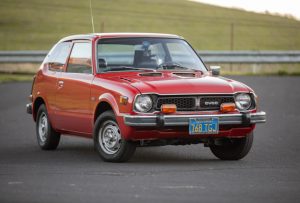








Here’s another story that hits nearly all your themes;
I wrecked my 2005 Sequoia last week. Rear ended a Mazda CX-3. Airbag went off, front plastic destroyed. The only metal damage was to the cross member where the hood locks. I drove it home, where the insurance company collected it to total. It only had 125k. And while it was a newer truck, so to speak, it lacked a lot of the bells and whistles my ’03 4Runner had. What it had was a buttery smooth V8, and large cargo area with the seats out/folded. I put drywall and 2x4s in it a few weeks ago, and was within 4″ of shutting the door.
The rental they gave me is a give-me-a-ticket bright red Durango. My list of complaints:
1. Zero torque. I had to lift the hood to check, because it was acting like a turbo-4. It’s a V6. A gelding.
2. It has that idiotic motor stop at a light feature. I have to turn it off every time. If it’s programmable, why can’t I default to “No”?
3. It has a sport button. When that’s pressed, it behaves as I expect a truck to behave. Why can’t I set that up as default – on?
4. It was cold here yesterday. I’m tooling down the road, and my hands and ass are getting hot. I nearly wrecked looking for the control. It’s not a button, but a selection called “Controls” on the radio panel, which isn’t visible unless the radio is on. WTF was it doing on? Decided I wanted it no doubt.
5. No clock. Seems lame, but I like the clock so I can see if I’m running late. That’s on the radio too.
6. There’s a “screen off” button. No way to turn the screen “on” except hit the power.
7. The instrument panel and controls are woeful screen fakes of real instruments in white and red. it’s the busiest display I think I’ve seen. And really annoying, because you can’t glance and understand what’s going on.
8. I just came back from bringing a couple hundred pounds of gear home. There was no difference in the ride, or feel of the sequoia loaded. This thing got real stiff, the handling and power curve changed. I’ve had suvs and minivans for years and never experienced that.
It’s a perfectly fine rental, though. And if I were given it as a company vehicle, I’d endure. But it doesn’t give me any reason to darken the doors of a Chrysler/Ram dealer ever.
I’m tempted to take the insurance money and go get an old toyota 4runner or pickup.
Hi Techie,
Yup! I miss my ’98 pick-up, which had metal bumpers and glass sealed beam headlights and almost no ssssssssssssssssaaaaafety crap except for the two air bags.
I hit a deer with it once; used come-alongs and a big tree to pull the bumper out – good as new! Try that with a plastic “fascia.”
I plan on getting another truck from the ’90s – – or the ’80s or the ’70s – when my current (’02) becomes too rusty to be worth repairing!
eric, I saw another square body on a trailer yesterday. Those old trucks are thick metal and bullet-proof drivetrains. My 93 is only slightly more pussy with not nearly as thick metal but the front and rear are tree-knocking stout. At least it is “diesel”, not computerized, not air bagged and no plastic on the and very little on the inside. The 98 is air bagged but it’s interior will be ditched for the 93 stuff…..when I can get another job. One thing nobody speaks of these days is the insurance companies age discrimination so work like I’ve always done is almost impossible to find……for me. A few days ago Celadon Trucking filed bankruptcy and left 3,000 drivers on the road with dead credit cards. I guess now they wish they’d paid more than field hand wages.
If all that broke was the airbag IP and front crossmember, why not try and get that fixed and have a project car at the end of it. It seems crappy to give one of those things up. If the Sequoia wasn’t such a gas guzzler, I would probably own one. It’s a damned nice truck/suv.
Short answer is time and money.
The salvage settlement would be about enough to fix it, if I could find an intact steering wheel. It needed read air springs, which I was dithering whether to do myself or have done. In the meantime, I’d need wheels.
They ended up giving me nearly $9K, which was more than I borrowed to buy it used a couple years ago. That allowed me to put a chunk of dough on a new used vehicle.
Sad thing is, Toyota trucks demand a premium. Even old ones. So my car dealer buddy had two 4runners on his lot. A 2000 and a 2008. Neither with 100K on them. Even with my family price and downpayment, I wouldn’t be able to swing the financing. The banks like 10 years old or less.
And, the old lady wouldn’t let me spend the cash for a beater truck, free and clear.
So. I got a 2011 Rav4. It’s got 60K on the clock and looks new. If my side business takes off, and we clear debt (in about a year) I think I’ll get an 80s-90s van. That vintage “mobile love palaces” are dirt cheap. And while I like pickups and SUVs, they command a premium where I live in Texas.
I rebuilt my Chevy with salvage money. It looked like new when done. And the replacement parts is one reason I’ll never have another jap truck. When I worked for the country we had two older pickups, one a Chevy and one a turd, uh, TRD. The damned hood wouldn’t stay up on the TuRD and it hadn’t been worked with all the heavy hauling and trailer pulling being done by the Chevy. Everything about the Chevy was much heavier duty. So if you want a pickup to do more than carry the kids and wife, you’d better get one from the Big 3 and parts wise, hope to hell nothing goes wrong with that Ram….or the Ford.
I love the commercial for the new F 150. Narrator “The new F 150, a highly complicated truck”…..the last thing I want.
Somebody tell me, if you have a truck with a/c, power steering, cruise control and electric door locks and windows, what else do you need? You can install a bluetooth for next to nothing. All that fancy stuff of 120V circuit is easily done with an inverter. The only thing ABS ever did for me was to cause the wreck that resulted in the salvage title in the first place.
I know how to modulate brakes. I wouldn’t be alive if I didn’t.
When I got my frame on the 93 straightened, the guys at the Chevy body shop told me if it had been a new pickup there would have been no need. Stay with what you have they said. Enough said.
I have found an old square body crewcab Chevy but it’s not 4WD, something I must have. I’ll find one…..maybe.
Oh wait, that was a “highly complex truck”. Geez, that was the end words for me. Ford’s require too many specialty tools to begin with. They don’t want you to fix one.
My square body is 2wd which is why the weeds are growing up around it. Maybe someday when I have the money I will fix it up just for the fun of it. Or maybe I will find a K-20 square body and use this one for some parts. The 89 K1500 works okay and so far has done everything I’ve asked it, but it’s still a pain to turn around in the woods and the damn doors are so heavy on a sidehill. Nice on the highway though. Too bad it’s so beat up.
I have a good 79 body but no driveline. It was a 2 WD too. But it was a hoss with a 454 and a TH 400. I suppose it wouldn’t be too difficult to stick a front drive axle under it but all those parts like steering gearbox and such are different on 4WD. Then again, all that stuff is once again being made new.
I don’t think it’s really practical to convert GM pickups from 2wd to 4wd unless you have a donor pickup, in which case you might as well fix up the donor. Worst case scenario just move the cab/box/etc over to the 4wd frame. The cab floor hump is different but one could probably salvage enough from the 4wd cab to convert it.
I’m just getting too old and tired to take on a major project like that.
Years ago I got offered an xcab lwb C-30 with a 454/AT for free, but I couldn’t imagine what I could use it for so I turned it down.
Oh shit, and it’s taken me over 7 years to find an X cab, long bed, manual, 4WD for a donor. I detest short beds.
The free C-30 was a 2wd automatic; worthless to me though it was a really nice pickup. It had been used to haul a big camper and to pull a fifth wheel.
I could somewhat get around in the mud and snow with a 2wd manual, but that big engine and an automatic would have been helpless. Back when we lived in town, some folks down the street had a C-20 similar to mine except an automatic. When we had a slick snow, their pickup would just sit in one place and spin when they released the brake, while I could just drive right away with a clutch.
I had a Honda Civic like in the last pic. Damn thing got like 50-60 mpg. I never had to gas it up, and I could park anywhere. It was a little busy on the highway, but it did OK.
Bought the thing for $250 from my Dad’s neighbor. He said he had it rebuilt, but it seemed to putter more than most. Drove it for a year, pulled the motor apart to rebuild the top end, and it turned out to have a busted exhaust valve. I had driven it for a year on 3 cylinders. Cost $150 for machine work, $40 for the gasket set.
Ran like a swiss watch after that.
Another thing you can’t do today.
Hi Techie,
Yup. I had several old VWs when I was young and – like you – bought them for next to nothing and kept them going for next to nothing. Which, as you note, is something you can’t do today. At least, not with anything “modern.”
Couple of exceptions worthy of mention: The Ford Flex is not an RWD wagon, but it IS bigger inside than the RWD wagons of old and has humongous seating capacity. Unfortunately I think they are going to cease production.
I have a Ford Focus sedan with a manual that will get 37-39 mpg on the highway, doing 75-80. It is truly more economical than the economy cars of old. Unfortunately they are ceasing production of that, too.
And don’t get me started on the absence of truly small, affordable trucks… I bought a ’99 Ranger base back in 2001 for — get this! $4200. Yes, a three-year old truck for four grand and change. You just try that today — I dare ya. It still ran like a champ at 213k… I only sold it because it rotted out. Damn near as simple and durable as a Model T.
The older I get, the more I feel like I’m going backwards, not forward…
Don’t forget the ethanol mandate that is now being raised to 15% blend from 10% (less gas in your gas). A back door attempt to kill the IC autos in favor for toasters on wheels.
Hi Allen,
Yup; I need to write about this business again – soon. Almost no cars made before 2000 are designed for 15 percent ethanol and its use will accelerate their “retirement,” as it were.
My ’76 TA is truly becoming a real-life Orange Barchetta.
Add: all small engines and motorcycle engines.
IF you live in a rural area, you can still get non ethanol, but it’s not avail. in urban areas. Had a local fuel supplier from another state come into our county and tried to add a non-ethanol pump for us farmers and the state said NO.
I have retired 3 nice older chainsaws to the parts bin with destroyed (eaten) carburetors from ethanol, even with additives. The local dealer says the new units can handle it with changed metallurgy, but that doesn’t make me much happier that I had to spend another couple grand on new ones.
ps: the AMA is actively lobbying Uncle to not imposed 15% across the board.
You can fix the chainsaws by cleaning out the carbs and rebuilding them. There’s a new kit for older Walboro(sp?) carbs that will replace the diaphragm with a design that won’t decay from ethanol. Or you can rebuild them stock and then used canned fuel. The canned pre-mix two stroke fuel does not have ethanol. Most if not all of the major chainsaw manufacturers offer their own branded canned fuel these days.
Also, most ethanol failures in small engines come from having them sit with fuel in them. If you drain the fuel from them or run them every month or so it will avoid most if not all of the problems. That maybe however for only stuff made since ethanol was mandated.
Before ethanol was mandated, a local station had ethanol fuel and I noticed it the day I filled a bunch of gas cans. I set them aside to use in the welder but must have gotten into one by mistake. I had a new Stihl 044 Mag chainsaw. I was cutting in really hot weather and all of a sudden it revved way up and that was that for the engine. The rubber pickup line had melted and sucked flat leaning it out to the point of galling it. I had it rebuilt and the new pickup tube was a hard material that ethanol won’t affect. I use additives to increase the fuel life but the main thing I’ve found is metal tanks keep fuel fresh much better than plastic, even if you keep the plastic cans in the dark. I don’t know why this is, just live by that rule of thumb.
Yeah, I blew up an 044 about 22 yrs ago but I don’t think it was the gas. I was working on the landing limbing and bucking big Ponderosa in 100 degree weather. A Husky is “better” in hot weather because it will just vapor lock and quit before it blows up – ha!
A few years ago I had to have the carb and fuel system rebuilt on my 046 because of the ethanol gas. Now I buy only non-ethanol premium for it which we can get at one station in town.
Anon, you have noticed the 044 and 046 both have summer and winter setting? I never bother to change mine from “summer”. I found out Amsoil 2 cycle oil was a miracle on 2 cyles though.
That’s because you don’t have any winter – hah!
It does help a little to be sucking warmer air off the top of the cylinder when it’s -20 F and the saw is under the snow sometimes. I used to walk the log while limbing when the just-dropped tree was lying on top of three feet of snow. That’s when you want a 30″ bar. Worked pretty good until you got the top bucked off and then had to jump off and wade through waist deep snow to the next tree. You can’t make any money like that, though, especially if you’re driving 60 miles from town to work. Or you can camp out in that cold. I went home one weekend, there was a storm, and it was near the end of the next week before the company got the road plowed out back to where I left my camper trailer.
We have cold weather and it’s damned cold some times. Not like you have but I consider below 0 as being pretty cold when you’ve been enduring 115 degrees for months during the summer.
We had a bitch of a winter in 15 that was cold for months but not record cold like some years. I believe it was 88 when we had 118 two days in a row. Our garden was large and the plants were really big. I use 6″ remesh for almost everything. Our plants were well outside it during that weather and the remesh burned the plants back to the inside of it. That winter we had -17 and that was a real bitch but it didn’t last long. In the winter of 83-84 we started it with a 20 inch snowstorm and nobody could do anything, not even 4WD could make it through that till the graders knocked it off the main roads. We lived a mile and a half back off in a pasture and just camped out with the dogs and cats. I had a large amount of milo stored and was feeding 5 covey of quail but every day there were fewer. It stay from -5 to 5 for a month and killed trees that were 150 years old. It killed livestock, wildlife and people. I fucked up and ran out of fuel cutting wood in -5 degrees, lost my grip on the fuel container and soaked my gloves but kept on cutting. It was a shock when I realized I had frostbit my hands. I threw the chainsaw in the back of the pickup, got in and cranked it up and made noises like a little girl. It was excruciating pain. My hands have never recovered so I’m the guy with really heavy gloves and face mask since I frostbit my face too. I had just never faced anything that extreme. You and the people where you live would never make that sort of mistake.
The only thing good about that winter was no need of a cooler for your beer and wine. In fact, we’d have to move it into the cab to keep it from freezing solid. I seem to recall drinking a good amount of Weller that winter. I remember cutting a huge amount of wood too. Cats would sit so close to the fireplace smoke would curl off their fur.
No regular fuel available where I live. I used to have a couple places between me and San Antonio I could get plain gas but that went away 10 years ago and now I can dive the 400 miles to SE of Seguin and not find anything but ethanol. You can normally go to a lake and pay a lot more for fuel and get pure gas but not on the beaten path.
There is a site online where you can find pure gas but it’s not accurate and every place in my part of the country that is listed doesn’t have it and hasn’t in 15 years.
My recollection from actually being there back then was that a 1970s long bed half ton two wheel drive pickup weighed about 3000 pounds, or maybe just a tad more. The common C-10 GVW was 5000 pounds so that “half ton” could carry almost a ton of driver, passengers, fuel, and bed load.
I don’t know the exact numbers today but I wouldn’t doubt that the average half ton pickup now weighs MORE than the GVW of 1970s half ton pickups – maybe a LOT more. I don’t know the exact weight but I think that my old C-50 GMC stripped down to cab and chassis only weighed about 6K. The GVW was 16K.
Anon, when I recall the pickups(Chevy pretty much only)from the 70’s I automatically think of the 4WD versions that were tough as nails and would climb a tree.
I think my 1973 K-20 weighed in at about 4K empty but I could be mistaken – maybe 4500# ?
I beat the heck out of mine. One time up in AK a bunch of us went out to glean firewood from a big powerline ROW. There were piles of free logs just waiting to be hauled off IF you could get to them. It was just a Cat trail in there. So we took my pickup and another fellow took a LR 90 with a little rented trailer. Lots of man (and girl!) power and I had stakes and a headache rack so we loaded up my pickup to the cab top with 8-10′ pieces and added the smaller longer ones sticking out over the top of the cab. We loaded a little bit in that trailer too. There was a steep muddy hill coming out. My K-20 went right up but the Rover and trailer bogged down near the bottom. I only had about 25′ of cable so I had to back about halfway down to hook up. The Chevy pulled that LR and trailer up that hill like it wasn’t hardly there. Of course I had so much weight that I couldn’t hardly spin a wheel – Ha!
People gave me sh1t about driving such a gas guzzler in those days, but guess who was always asking me to help them move, or haul something? I hauled big loads of firewood over and over for the church but then they said I never did anything 🙁
The new pickups might have power and load capacity, but you would bust all that plastic off the front end the first little dip that you tried to drive through. I probably had four of us crammed in the bench seat so who needs a 4 door? LOL
I guess it’s no wonder that the TH350 was shot after about 75K miles 😉
If I had ordered it with the SM465, I might still have it today. But we just never considered that they would quit making tough simple pickups like that. Why fix it when you can just buy another one?
Those cars of the 90s had significantly less hp than today’s cars. Hell, mine only has 90 hp and gets by. I wonder if more economy could be achieved with less power today. Or is that unachievable due to the extra weight?
Hi Bin,
Yes, of course – but they had less horsepower precisely because they weighed less! Today’s cars have to have more horsepower… just to get moving!
Audi makes a v8 wagon still, the RS6. It doesn’t seat so many people and not rear facing and it certainly is no middle class vehicle, but it does have almost 600 hp. It’s also probably full of computers I wouldn’t want and stupid safety features that are so annoying I couldn’t drive the thing.
Hi Mark,
Yes – but that car is an exotic (and exotically priced). There is no such thing (anymore) as a V8/RWD full-size wagon you can buy new for less than $30k. Or even $50k.
Seemed to me that wagons and big sedans went out of favor for a while (with John Q Public) back in the 90s. Minivans and SUVs were becoming more popular at the time.
Now I’m seeing the (nostalgic?) demand for wagons driving (used) prices higher. Even the big sedans are bringing higher asking prices – with a few exceptions.
“Anyhow, the government decided on behalf of car buyers – and without having asked them – that they would have cars that got good gas mileage . . . whether they wanted them or not. ”
Which is why EVs stand a good chance of succeeding,,, whether they’re better or not,,, whether we want them or not. At least that seem the trend of government interference. Light bulbs, toilets, cars, you name it they regulate it.
“…you name it they regulate it.”
Number of federal (regulating) agencies: 451 https://www.federalregister.gov/agencies
Witness the hissy fit this weekend over Trump complaining about low flow toilets and shower heads. Why, what makes him an expert in plumbing technology! I’ll bet he hasn’t even brought up the subject with the meritocracy in charge of determining the ideal amount of water flow! The EPA is not amused.
One tries to laugh, but the underlying outrage only increases. They could have taken the Trump presidency as a sign they’re pushing too hard, or that the Congress has given too much power away, or that the states are nothing more than gelded supplicants, fighting amongst themselves for the scraps at the end of the buffet line. But instead they blame us, those who mock their enlightenment, for all that’s rotten in Foggy Bottom. For you see, they aren’t but mere men, they’re bureaucrats, in complete control over their amygdala, using only logic and reason to calculate the one true ideal. The only thing that prevents them from fulfilling their manifest destiny is us, those who won’t play along and let them be in charge.
China is the ideal model to these people. China spills a lot of ink showing off the “failure” of democracy. But what they see as failure is really the whole point. Centralized power is how you get massive disasters like the One Child Policy, the ghost cities, the environmental disasters and tainted food supply, and all the other wonders of daily life in the Middle Kingdom.
Centralized power is how you get massive disasters like the One Child Policy,
Centralized power is how you get massive disasters like the Obamacare…
Why, what makes him an expert in plumbing technology! I can tell ya, he uses toilets and showers. He said it takes several flushes to flush the logs one dumps on occasion. He takes 25 minutes to take a shower where ten minutes where tops and you were cleaner and smelled better then now. I agree with him, get the epa and the states out of out toilets and showers, as well as all the other asswipe alphabet agencies that have to stick their nose under the tent.
FWIW, the used water saver terlet (“commode” for southerners – ha!) that I bought from Habitat flushes 10x better than the 30-something year old one that I pulled out. It shoots the main water flow right in the bottom of the bowl and whooshes everything out one flush, where the old one sort of fast trickled all the water from the lip of the bowl and hoped it would be enough to float everything out of the trap. I do think the little water passages in the old one were about half plugged up by the minerals in our well water.
I am pretty pissed with these new faucets that just trickle water even with the handle turned all the way on 🙁 You can turn them on then just about go for a walk while waiting for hot water to come out.
I feel your pain. Our water eats up everything but plastic, brass and the very best SS, such as submersible pumps are made of.
Iron and iron bacteria are a big problem here. Eats up pressure tanks and pumps alike. You can spend double to have a better well installed but nobody ever wants to do that. Seen one exception in 30 years. Dunno if that’s a viable option in your area.
I imagine a carbon filter would help but I’m not a treatment expert, just a driller…
dbb, iron and gyp are the bane of our water situation. Our ground will eat through pipes at ground level.
Like Anon, I’ve had the water quit running and go to the pumphouse to find a similar situation. I try to keep enough plumbing fittings and Pex to make any repair I need to do.
iron/steel (and stainless) do not like to be in contact with clay soils (and residual soil which is what I suspect you have). It will corrode rapidly.
Best practice is to surround it with clean dry sand. Sometimes we’ll install cathodic protection too (for buried tanks).
If you’re getting bio-film build up (red/black slime), circulating a high sodium solution in the well will cut it way back.
We have the opposite problem. We in the shinery sand and the water table used to get up to the top of the ground. But the sand and entire country is red dirt, lots or iron and gyp. I’ve had galvanized pipes break off at ground level. Sat. tv wasn’t working one day so I went to check it out. The whole thing was on the ground with the galvanized pipe eaten up at ground level. Same for clothesline, went out and found it lying in the yard. I used two bigger, heavier pieces of pipe in the ground and stuck the rest of it into those pipes putting bolts through it all. The Kennels have posts that are eaten up and broken off. The best thing I ever used was old oil pipeline that was wrapped with asphalt and liner. Pex has been a life-saver for us since it will freeze and not burst, not even the fittings or faucets. Great stuff that doesn’t clog up or corrode.
red dirt = residual soil.
It’s basically weathered limestone and calling it soil is a bit of a stretch.
I’ll bet you find chert nodules all through it too.
Not familiar with ‘shinery sand’
No chert in this county except on RR’s. West Texas is red dirt with most of it being clay. There’s some limestone pits here and there but none in this county. We do have quite a bit of gypsum with US Gypsum having the largest gypsum/production factory in the world near Sweetwater, Texas.
And calling it “weathered limestone” would be quite a stretch since you have to go to other counties to find limestone and no big pits like in central Texas. The soil here is quite good. It was originally plains covered in grass, hence the name “Rolling Plains”. There are great crops grown here and the edible types taste better than the soil SE of us where you get into black dirt.
It’s great country for melons of all sorts and the red soil runs fairly much to the Davis Mountains. “Pecos cantaloupe” are world renowned for their superior taste. To be accurate, we has such a small amount of limestone we have to resort to using clay with a lot of gravel in it for roads instead of the preferred limestone. They’re widening the FM road near us and hauling the limestone from 60 miles to the SW of us.
Too bad I guess, that we drove through your neighborhood in the dark back thirty years ago. Left Fredericksburg sometime during the day and headed out through Brady? and Eden and up through Ballinger, etc. Ended up at a rest area on 84 somewhere NW of Sweetwater. We were headed through Lubbock to see some long lost relatives of mine.
Eight,
guess I’d have to see it but if it is chert free then it’s likely not what I was thinking of.
I should have more stuff. I borrowed some fittings and reducers from a neighbor to splice it back together without a shutoff until I could get to town and buy new plastic valve and fittings.
Old guy at the HW store had a good idea: just screw a plug into a threaded tee and skip the drain valve. Pull the plug if you ever need to drain the house.
I’ve rigged just about everything at one time or another, use a faucet for a plug.
A couple years ago, our water quit right before we went to bed. Wifey said leave it until morning, but I went to check it out. Breaker and fuse were okay and I could hear the pump running. Went down to the cellar and water running everywhere! A fitting between the main shut off valve and the drain valve had rusted off but the main valve could still be turned off.
Everything down there was plastic except for the shut off valve, reducer fittings, and drain valve. I replaced ALL of that with plastic. Cheaper and it doesn’t rust.
Garden plants don’t like the water either, but on the good side there is lots of it. Pump can never run it dry.